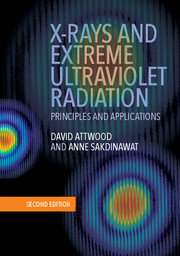Book contents
- Frontmatter
- Dedication
- Contents
- Preface to the Second Edition
- Acknowledgments for the Second Edition
- Preface to the First Edition
- Acknowledgments for the First Edition
- 1 Introduction
- 2 Radiation and Scattering at EUV and X-Ray Wavelengths
- 3 Wave Propagation and Refractive Index at X-Ray and EUV Wavelengths
- 4 Coherence at Short Wavelengths
- 5 Synchrotron Radiation
- 6 X-Ray and EUV Free Electron Lasers
- 7 Laser High Harmonic Generation
- 8 Physics of Hot Dense Plasmas
- 9 Extreme Ultraviolet and Soft X-Ray Lasers
- 10 X-Ray and Extreme Ultraviolet Optics
- 11 X-Ray and EUV Imaging
- Appendix A Units and Physical Constants
- Appendix B Electron Binding Energies, Principal K- and L-Shell Emission Lines, and Auger Electron Energies
- Appendix C Atomic Scattering Factors, Atomic Absorption Coefficients, and Subshell Photoionization Cross-Sections
- Appendix D Mathematical and Vector Relationships
- Appendix E Some Integrations in k, ω-Space
- Appendix F Lorentz Space-Time Transformations
- Appendix G Some FEL Algebra
- Appendix H Ionization Rates of Noble Gas Atoms as a Function of Laser Intensity and Pulse Duration at 800 nm Wavelength
- Index
Preface to the First Edition
Published online by Cambridge University Press: 24 November 2016
- Frontmatter
- Dedication
- Contents
- Preface to the Second Edition
- Acknowledgments for the Second Edition
- Preface to the First Edition
- Acknowledgments for the First Edition
- 1 Introduction
- 2 Radiation and Scattering at EUV and X-Ray Wavelengths
- 3 Wave Propagation and Refractive Index at X-Ray and EUV Wavelengths
- 4 Coherence at Short Wavelengths
- 5 Synchrotron Radiation
- 6 X-Ray and EUV Free Electron Lasers
- 7 Laser High Harmonic Generation
- 8 Physics of Hot Dense Plasmas
- 9 Extreme Ultraviolet and Soft X-Ray Lasers
- 10 X-Ray and Extreme Ultraviolet Optics
- 11 X-Ray and EUV Imaging
- Appendix A Units and Physical Constants
- Appendix B Electron Binding Energies, Principal K- and L-Shell Emission Lines, and Auger Electron Energies
- Appendix C Atomic Scattering Factors, Atomic Absorption Coefficients, and Subshell Photoionization Cross-Sections
- Appendix D Mathematical and Vector Relationships
- Appendix E Some Integrations in k, ω-Space
- Appendix F Lorentz Space-Time Transformations
- Appendix G Some FEL Algebra
- Appendix H Ionization Rates of Noble Gas Atoms as a Function of Laser Intensity and Pulse Duration at 800 nm Wavelength
- Index
Summary
This book is intended to provide an introduction to the physics and applications of soft x-rays and extreme ultraviolet (EUV) radiation. These short wavelengths are located within the electromagnetic spectrum between the ultraviolet, which we commonly associate with sunburn, and harder x-rays, which we often associate with medical and dental imaging. The soft x-ray/EUV region of the spectrum has been slow to develop because of the myriad atomic resonances and concomitant short absorption lengths in all materials, typically of order one micrometer or less. This spectral region, however, offers great opportunities for both science and technology. Here the wavelengths are considerably shorter than visible or ultraviolet radiation, thus permitting one to see smaller features in microscopy, and to write finer patterns in lithography. Furthermore, optical techniques such as high spatial resolution lenses and high reflectivity mirrors have been developed that enable these applications to a degree not possible at still shorter wavelengths. Photon energies in the soft x-ray/EUV spectral region are well matched to primary resonances of essentially all elements. While this leads to very short absorption lengths, typically one micrometer or less, it provides a very accurate means for elemental and chemical speciation, which is essential, for instance, in the surface and environmental sciences. Interestingly, water is relatively transparent in the spectral region below the oxygen absorption edge, providing a natural contrast mechanism for imaging carbon-containing material in the spectral window extending from 284 to 543 eV. This provides interesting new opportunities for both the life and the environmental sciences.
Exploitation of this region of the spectrum is relatively recent. Indeed the names and spectral limits of soft x-rays and extreme ultraviolet radiation are not yet uniformly accepted. We have chosen here to follow the lead of astronomers, the lithography community, and much of the synchrotron and plasma physics communities in taking extreme ultraviolet as extending from photon energies of about 30 eV to 250 eV (wavelengths from about 40 nm to 5 nm) and soft x-rays as extending from about 250 eV (just below the carbon K edge) to several thousand eV (wavelengths from 5 nm to about 0.3 nm). The overlaps with ultraviolet radiation on the low photon energy side and with x-rays on the high photon energy side of the spectrum are not well defined.
- Type
- Chapter
- Information
- X-Rays and Extreme Ultraviolet RadiationPrinciples and Applications, pp. xv - xviiPublisher: Cambridge University PressPrint publication year: 2017

